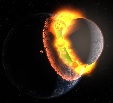| Diakonov | Date: Wednesday, 28.12.2016, 20:16 | Message # 1 |
|
Astronaut
Group: Users
 Brazil
Brazil
Messages: 69
Status: Offline
| I noticed that atmospheres composition are randomly generated, like planets. Even in a system that I'm creating, if I don't define an atmosphere composition, depending on the world type and mass, it will have an atmosphere. That's ok but...
Some very small worlds will have an odd atmosphere. For example, I created a planet that had about the same size of the moon, it was way too hot (above 1000 ºC) and it had an atmosphere. I doubt even heavier gases would be kept by such world, as if the rocky soil of such world was evaporating...
And as for the randomly generated atmopsheric composition... some gases shouldn't be so common. Example, an earth-like world with so much gases such as H2O, CH4, NH3, SO2, H2S, C2H2, H2, He... Shoudn't gases like these be, as a norm, always minor or trace gases instead of main gases (for earth-like worlds)? For He and He, maybe a very massive rocky world and cold enough, but smaller and hotter worlds? Shouldn't planets similar to Earth (with similar atmosphere), had more N2 and O2 instead of CO2, H2O, H2S, NH3, SO2, CH4 or any other gases that are not so stable? And also the fact that Space Engine still don't consider the type of gases involved to determine it's greenhouse.
I suggest that generated gases should be determined mainly by the kind of atmosphere (such as Terra, Mars, Venus, etc). In fact, I think it would be better if:
Volcanic: The color and gases of what would be a torrid volcanic planet (NaCl, CO, SO);
Venusian: The color and gases of what would be a venusian world (CO2 and SO2);
Earthlike: The color and gases of what would be an earth-like planet (N2 and O2);
Martian: The color and gases of what would be a mars-like planet (CO2);
Gaseous: The color and gases of what would be any gas giant planet (H2 and He);
Icegaseous: The color and gases of what would be any ice giant planet (H2, He, CH4, NH3, H2O);
Oceania: The color and gases of what would be any oceania planet (almost pure N2 or H2 with some H2O, CH4, whatever);
Hydrocarbonic: The color and gases of what would be any hydrocarbon or carbon rich planet (N2, CH4, C2H6, etc);
Halogenic: The color and gases of what would be any halogenic rich planet (N2, O2, F2, Cl2, PF5, etc);
Ammonic: The color and gases of what would be any ammonia rich planet (N2, NO2, N2O, PH3 etc);
Inert: The color and gases of what would be any planet having atmosphere mostly of inert gases (He, Ar, Kr, Xe, etc);
Or maybe I'm missing more potential types of atmospheres?
All of these types of atmospheres would have minor and trace gases too!
Is this idea worth at all? Or maybe earth-like blue air should be mostly made of H2O and CO2 after all?
A CO2, SO2 rich planet with blue skies, really? Looks like that those who think that martian air is actually blue are right... In that case, why bother including a red sky in Space Engine database? But this is for another topic, right?
|
| |
| |
| Alek | Date: Wednesday, 28.12.2016, 22:31 | Message # 2 |
 Pioneer
Group: Users
 United States
United States
Messages: 326
Status: Offline
| Mars' atmosphere is red because of the dust brought into the atmosphere, and Venus' atmosphere is tan because of the S02 and sulfuric acid content. Earth's is blue because there's not any really colored gasses so it's colored by how the light is scattered away rather than by the color of the gasses in the atmosphere and there isn't enough dust in the atmosphere to tint it like Mars'
As far as composition, yes, it needs to get better but its very new. However an earthlike planet could have a CO2-heavy atmosphere if the plants and animals ignore it or if it plays the role of, say, nitrogen-- pretty inert but still used. As far as H2O, enough evaporation could cause a planet to be heavy with it; say, a ormal terr except with enough water to cover the surface, but it becomes so hot over time that continents form under thick cloud layers simply because it's so hot that the oceans stay in the air...in fact, that might have once been what venus was like before it all escaped to space.
Living among the stars, I find my way. I grow in strength through knowledge of the space I occupy, until I become the ruler of my own interstellar empire of sorts. Though The world was made for the day, I was made for the night, and thus, the universe itself is within my destiny.
|
| |
| |